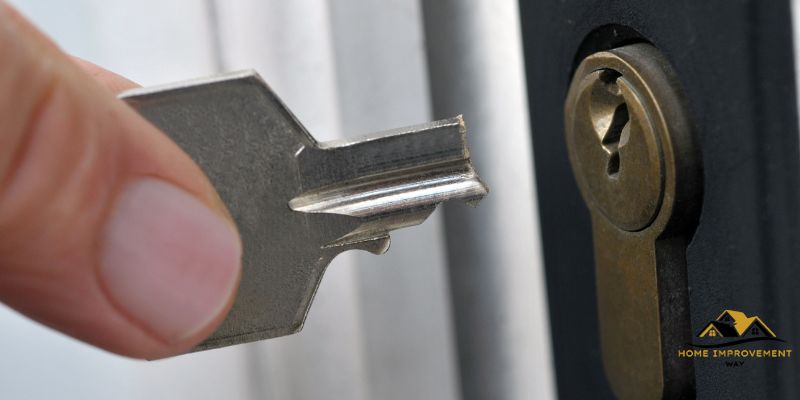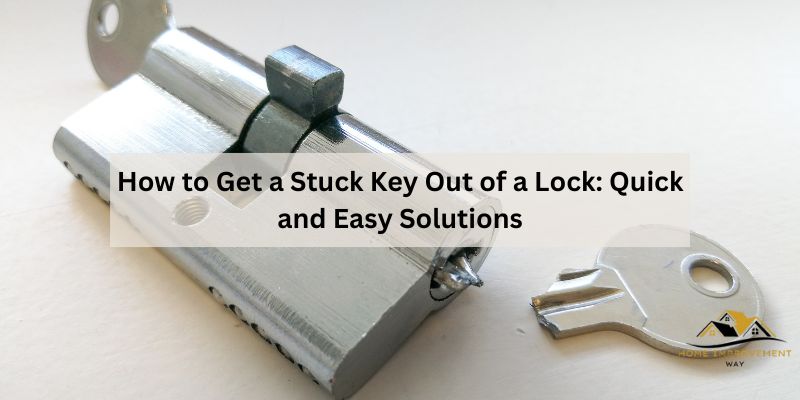To get a stuck key out of a lock, you can use lubricants or graphite powder to ease the movement and gently jiggle the key. Additionally, you can use pliers or a key extractor tool if the key is still stuck.
Lastly, if all else fails, it may be necessary to call a professional locksmith for assistance. It is important to be patient and avoid using excessive force that could damage the lock. Regular maintenance and cleaning of the lock can also help prevent keys from getting stuck in the future.
So, follow these steps to remove a stuck key from a lock without any hassle.
Inspect The Key
Having trouble with a stuck key in a lock? Learn how to safely remove it with these helpful tips and techniques from Inspect the Key. Discover the best methods to free your key without damaging the lock.
When a key gets stuck in a lock, it can be incredibly frustrating. Instead of panicking and resorting to extreme measures such as breaking the key or damaging the lock, try a few simple steps to get the key out. The first step is to inspect the key closely to identify any visible damage or debris that might be causing the problem.
Check For Visible Damage
Begin by carefully examining the key for any signs of visible damage. Look for bends, twists, or any irregularities that could be preventing it from turning freely inside the lock. If you notice any damage, it’s important not to force the key as this could worsen the situation and even break the key inside the lock.
If the key is bent, you can try gently straightening it using pliers or a similar tool. Be cautious and apply only slight pressure to avoid breaking the key entirely. However, if the key is severely damaged or broken, it may be necessary to seek professional help to avoid causing further damage to the lock.

Clean The Key
In addition to checking for visible damage, it’s essential to clean the key to remove any dirt, debris, or grime that may be hindering its smooth operation. Over time, keys can accumulate dirt and become sticky, making it difficult for them to slide in and out of the lock smoothly.
Start by wiping the key with a clean, dry cloth to remove any surface dirt. Then, you can use a mild household cleaner or rubbing alcohol to clean the key more thoroughly. Apply the cleaner to a cloth or cotton swab and gently rub it along the key, paying attention to the grooves and edges.
If the key has stubborn dirt or debris stuck in the crevices, you can use a toothbrush or a small brush to gently scrub it away. Be careful not to use excessive force as this could cause damage to the key or the lock.
Once you have cleaned the key, give it a final wipe with a dry cloth to remove any excess cleaner or moisture. This will help ensure a smooth operation when inserting the key into the lock.
By inspecting the key for visible damage and cleaning it thoroughly, you can increase the chances of successfully removing a stuck key from a lock. However, if these steps do not resolve the issue, it’s best to seek professional assistance to avoid causing further damage to the lock or the key.
Lubricate The Lock
To get a stuck key out of a lock, one effective solution is to lubricate the lock. Applying a lubricant such as graphite or WD-40 can help loosen the key and ease it out smoothly. This simple technique can save you from the frustration of a stubborn lock.
Use Graphite Powder
Graphite powder is a widely recommended lubricant for stuck keys. It’s ideal for locks because it reduces friction and helps the key glide smoothly. Here’s how to use graphite powder to get a stuck key out of a lock:
- Start by cleaning any debris or dirt from the area around the keyhole.
- Next, insert the key partially into the lock and gently wiggle it to distribute the graphite powder inside the lock.
- Slowly remove the key and firmly tap the lock cylinder to allow the graphite powder to settle.
- Finally, reinsert the key into the lock completely and wiggle it back and forth to distribute the lubricant further.
Try Silicone Spray
Silicone spray is another effective lubricant that can help free a stuck key. It offers excellent performance in reducing friction and preventing rust. Here’s how you can use silicone spray to lubricate the lock:
- First, clean the lock surface and keyhole to remove any dirt or grime.
- Next, apply a small amount of silicone spray directly into the keyhole.
- Insert the key and slowly turn it back and forth to distribute the silicone spray throughout the lock.
- Afterward, remove the key and wipe away any excess spray.
- Reinsert the key and test the lock to see if it moves smoothly.
Apply Pressure And Jiggle
To get a stuck key out of a lock, apply pressure and jiggle it gently. This technique helps to loosen the key’s grip and allows for easier removal without damaging the lock.
Applying pressure and gently jiggling the key can be an effective method to get a stuck key out of a lock. This technique is often used when the key is stuck due to debris or misalignment within the lock mechanism.
Insert The Key Fully
Before attempting to apply pressure and jiggle the key, make sure to insert the key fully into the lock. This ensures that you have a firm grip on the key and allows for better control and maneuverability.
Apply Steady Pressure And Jiggle The Key
Once the key is inserted fully, apply steady pressure in the direction you would normally turn the key to unlock the lock. This pressure helps dislodge any debris or obstructions that may be preventing the key from turning smoothly.
While maintaining this pressure, gently jiggle the key back and forth and up and down. This motion can help to realign the internal pins or tumblers within the lock and improve the chances of freeing the stuck key.
It’s important to be patient and take your time with this process. Rushing or using excessive force can potentially damage the key or the lock. So, be gentle and persistent in your efforts.
If the key doesn’t turn or the lock remains stuck, it’s advisable to seek professional assistance from a locksmith. They have the expertise and tools to safely and effectively resolve the issue without causing further damage.
Remember, whether you’re dealing with a stuck key or any other lock-related problem, proper maintenance and regular lubrication can help prevent such issues in the future. Regularly cleaning and lubricating your locks can ensure their smooth operation and longevity.
Use Pliers Or Tweezers
You can easily remove a stuck key from a lock by using pliers or tweezers. Simply grip the key firmly and gently pull it out to avoid any damage to the lock.
Try Pliers For Better Grip
If your key is stuck in a lock and you’re struggling to remove it, using pliers can provide a better grip for easier extraction. Pliers have a strong grip that can effectively grasp onto the key, making it easier to maneuver and remove it from the lock. To use pliers, follow these steps:
- Begin by selecting a pair of pliers that best fit the key and lock.
- Ensure that the pliers are clean and free of debris before using them.
- Gently insert the tip of the pliers into the keyhole, ensuring you don’t damage the lock itself.
- With a firm grasp, carefully pull the pliers outward, applying steady pressure.
- While pulling, try wiggling the key back and forth to help release any stuck pins within the lock.
- If necessary, you can also try rotating the pliers slightly to dislodge the key.
- Continue this process until the key successfully comes out of the lock.
Using pliers can be highly effective, as they provide a firm grip and enable you to apply the right amount of force to remove the stuck key. Just remember to handle the pliers with care to avoid damaging the lock or key in the process.
Use Tweezers For Precision
If you’re dealing with a small lock or a key that is stuck deep within the lock mechanism, tweezers can be a great tool for precise extraction. Tweezers enable you to reach smaller and hard-to-reach areas, giving you better control over the key removal process. Follow these steps to use tweezers effectively:
- Start by selecting a pair of tweezers with thin and precise tips, ensuring they are clean and free of any debris.
- Gently insert the tip of the tweezers into the keyhole and try to grab onto the key.
- If the key is deep within the lock, carefully maneuver the tweezers to reach it without causing any damage.
- Once you have a firm grip on the key, gently pull it out, ensuring you apply steady and even pressure.
- Be patient and avoid forcing the key out, as this may cause it to break inside the lock.
- Continue adjusting the position of the tweezers as needed until the key is successfully extracted.
Using tweezers can take time and precision, but they can be an excellent tool for removing stuck keys, especially in smaller locks or tight spaces. Make sure to be gentle and patient during the process to avoid any further complications.
By following these steps and using the appropriate tools like pliers or tweezers, you can successfully remove a stuck key from a lock. Remember to handle the tools carefully and avoid excessive force to prevent any damage to the key or lock itself.

Call A Professional Locksmith
Having trouble removing a stuck key from a lock? Call a professional locksmith for expert assistance. They have the skills and tools needed to safely extract the key without causing any damage to the lock.
If you’ve tried all the common methods to remove a stuck key from a lock and have had no success, it’s time to call a professional locksmith. They have the necessary skills and tools to safely extract the key without causing any further damage to the lock.
When All Else Fails
When all else fails and you can’t remove the stuck key on your own, don’t panic. A professional locksmith is your best option to solve the problem effectively and efficiently. Attempting to force the key out or using excessive strength can lead to irreversible damage to the lock, resulting in costly repairs or even replacement.
Avoid Damaging The Lock Further
One of the crucial reasons to call a professional locksmith is to avoid causing any more damage to the lock. Locksmiths have the expertise to carefully assess the situation and determine the best approach to extract the stuck key without harming the lock mechanism.
When you call a locksmith, they will arrive with the necessary tools and equipment to safely handle your lock and key issues. They have specialized techniques and knowledge that allow them to remove the stuck key without causing any additional damage.
By relying on a professional locksmith, you can have peace of mind knowing that they will take the utmost care in handling your lock and key situation. Their expertise will not only remove the stuck key but also ensure that your lock remains functional and secure.
Remember, attempting to fix a stuck key without the proper training can lead to more harm than good. It’s always best to trust the professionals who have the skills and experience to handle these situations with precision and care.
Conclusion
If you’re dealing with a stuck key in a lock, don’t panic! With a few simple tools and techniques, you can free it up without damaging the lock. Remember to approach the situation calmly and follow the steps carefully. By using lubricants, tapping the key gently, or seeking professional help if needed, you’ll soon have that stubborn key out and your lock back in working order.
Don’t let a stuck key ruin your day when there are easy solutions at hand. Take control and solve this problem with confidence!


